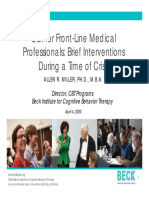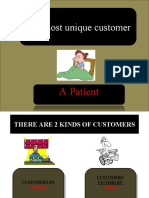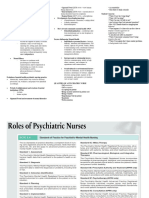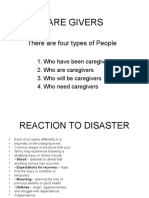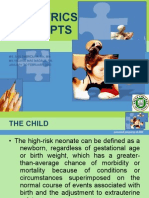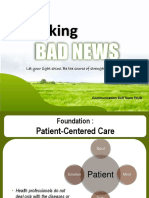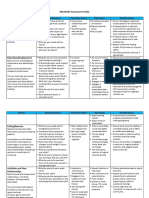Community CMS
Community CMS
Uploaded by
Joanna Ephraim CruzCopyright:
Available Formats
Community CMS
Community CMS
Uploaded by
Joanna Ephraim CruzCopyright
Available Formats
Share this document
Did you find this document useful?
Is this content inappropriate?
Copyright:
Available Formats
Community CMS
Community CMS
Uploaded by
Joanna Ephraim CruzCopyright:
Available Formats
Focused Review: NR441/442/444
June 2021
Presenter Tanya Spillman, MSN, RN
Content Mastery Series
• This 60-item test offers an assessment of basic comprehension and mastery of community
health principles including:
• Foundations of community health (client advocacy, health promotion and disease
prevention, epidemiology, ethical decision-making, family and cultural care, environmental
health, national health care goals)
• Community assessment and diagnosis, and health program planning and evaluation
• Community health education
• Roles and settings for community health nursing
• Nursing care of aggregates in the community
• Special community needs
• Community protection and client safety (disaster preparedness, communicable disease)
• You have 60 minutes to complete the assessment.
©2021 Chamberlain University LLC. All rights reserved. 2
Management of Care
©2021 Chamberlain University LLC. All rights reserved. 3
End-of-Life Care
• Comfort needs near the end
of life:
• Physical Comfort
• Mental and Emotional
Needs
• Spiritual Issues
• Practical Tasks
Always talk to, not about, the person who is dying!
©2021 Chamberlain University LLC. All rights reserved. 4
Hospice Care
• Focus on pain control and comfort
• Die with dignity
• Provide honest Information:
• Prognosis
• Disease progression
• Treatment options
• Effects of treatment
©2021 Chamberlain University LLC. All rights reserved. 5
Grief and Loss
Factors Influencing Loss, Grief, and Coping Ability
• Developmental stage
• Social support networks
• Type and significance of the loss
• Culture and ethnicity
• Spiritual and religious beliefs and practices
• Prior experience with loss
• Socioeconomic status
©2021 Chamberlain University LLC. All rights reserved. 6
Grief and Loss: The
Grief Process
• Five Stages of Grief
• Denial – The client has difficulty believing a terminal
diagnosis or loss.
• Anger – Anger is directed toward self, others, or
objects.
• Bargaining – The client negotiates for more time or a
cure.
• Depression – The client mourns and directly confronts
feelings related to the loss.
• Acceptance – The client accepts what is happening
and plans for the future.
©2021 Chamberlain University LLC. All rights reserved. 7
Management of Care
‣ A home hospice nurse is caring for a client who is dying. A family member is talking
with the nurse, which statement requires clarification by the nurse?
A. “Although my father can’t get around very much, at least he is alert.”
B. “My siblings and I have a schedule of when we are available to provide care for
our father.”
C. “My biggest concern is that I don’t want my father to be in any pain.”
D. “I’m glad that professionals will be here in case my father stops breathing.”
©2021 Chamberlain University LLC. All rights reserved. 8
Rationale
A. “Although my father can’t get around very much, at least he is alert.”
B. “My siblings and I have a schedule of when we are available to provide care for
our father.”
C. “My biggest concern is that I don’t want my father to be in any pain.”
D. “I’m glad that professionals will be here in case my father stops breathing.”
©2021 Chamberlain University LLC. All rights reserved. 9
Mandatory Reporting
• Suspected Abuse
• Children, dependent adults and
Obligation to elderly
Report • Communicable Diseases
• CDC-60+ communicable diseases
are reportable
What are some examples?
©2021 Chamberlain University LLC. All rights reserved. 10
Management of Care
‣ A nurse should prepare to notify public health officials about which of the following
client infections? (Select all that apply)
A. Gonorrhea
B. Hepatitis C
C. Clostridium difficile
D. Chlamydia trachomatis
E. Meningococcal disease
©2021 Chamberlain University LLC. All rights reserved. 11
Rationale
A. Gonorrhea
B. Hepatitis C
C. Clostridium difficile
D. Chlamydia trachomatis
E. Meningococcal disease
©2021 Chamberlain University LLC. All rights reserved. 12
©2021 Chamberlain University LLC. All rights reserved. 13
Modes of Transmission
Airborne Foodborne Waterborne Vector-borne Direct contact
• Measles • Norovirus • Cholera • West Nile virus • STI
• Chickenpox • Salmonellosis • Typhoid fever • Lyme Disease • Infectious
• TB • Hepatitis A • Bacillary • Rocky mononucleosis
• Pertussis • Trichinosis dysentery Mountain • Enterobiasis
• Influenza • E. coli • Giardia lamblia spotted fever • Impetigo
• SARS • Malaria • Lice, scabies
©2021 Chamberlain University LLC. All rights reserved. 14
Case Manager
• Collaborative process
• Decrease costs/improving client outcomes
• Advocates for client’s rights and health care needs
Continuity Referrals
of Care • Restoring, maintain, or promoting health
• Community resources
• Acute settings-based on medical diagnosis
*What are some barriers that might
impact the referral process?
©2021 Chamberlain University LLC. All rights reserved. 15
Management of Care
‣ A case management nurse is preparing to initiate referrals for a client as part of
discharge planning. Which of the following actions should the nurse take first?
A. Monitor the client’s satisfaction with the referral.
B. Provide the client information to referral agencies
C. Review available resources with the client
D. Identify referrals that the client needs
©2021 Chamberlain University LLC. All rights reserved. 16
Rationale
A. Monitor the client’s satisfaction with the referral.
B. Provide the client information to referral agencies
C. Review available resources with the client
D. Identify referrals that the client needs
©2021 Chamberlain University LLC. All rights reserved. 17
Home Health
• Community Health Nurses
• Traditional Homes
• Assisted Living Facilities
• Nursing Homes
• Skilled Services
• Assessment
• Wound care
• Medication administration
• Parenteral nutrition
• IV fluids
• Central line care
• Urinary catheter care
©2021 Chamberlain University LLC. All rights reserved. 18
Safety and Infection Control
©2021 Chamberlain University LLC. All rights reserved. 19
Safety and Infection Control
‣ At the scene of a train crash, the nurse triages the victims. Which
clients should be coded for triage as most urgent or the first priority
(color red)? Select all that apply
1. Is dead
2. Has chest pain
3. Has a leg sprain
4. Has a chest wound
5. Has multiple fractures
6. Has full thickness burns over 30% of the body
©2021 Chamberlain University LLC. All rights reserved. 20
Rationale
1. Is dead No, this client would be in the black category.
2. Has chest pain Yes, this client would be in the red category.
3. Has a leg sprain No, this client would be in the green category.
4. Has a chest wound Yes, this client would be in the red category.
5. Has multiple fractures No, this client would be in the yellow category.
6. Has full thickness burns over 30% of the body Yes, this client would be red since
they have less then 65% burns on their body.
©2021 Chamberlain University LLC. All rights reserved. 21
Emergency Preparedness
©2021 Chamberlain University LLC. All rights reserved. 22
Disaster Management Stages
Preparedness and
Prevention Stage Response Stage Recovery Stage
Planning Stage
• Assess areas at • Identify Specific • Triage • Heroic
risk Roles • Coordinate • Honeymoon
• Identify threats • Disaster Kits Evacuation • Disillusionment
and • Quarantine • Reconstruction
vulnerabilities • Open Shelters
©2021 Chamberlain University LLC. All rights reserved. 23
Home Safety
• Grab bars
• Nonskid strips in tub
• Sturdy footstool
• Adequate railing on stairway
• De-clutter stairs / pathways
• Adequate lighting (e.g., stairs, thresholds)
• Furniture (e.g., soft, appropriate height, steady)
• Cords & electrical Hazards not exposed
©2021 Chamberlain University LLC. All rights reserved. 24
Safety and Infection Control
‣ A home health nurse is performing an assessment of an older adult client’s home.
Which should the nurse identify as a potential hazard?
A. Hot water temperature at 46 degrees Celsius (115 degrees F)
B. A night light in each room of the house
C. A secured, large area rug in the living room
D. Wires for the television tunneled under the carpet
©2021 Chamberlain University LLC. All rights reserved. 25
Rationale
A. Hot water heater temperature at 46 degrees C (115 degrees F)
B. A night light in each room of the house
C. A secured, large area rug in the living room
D. Wires for the television tunneled under the carpet
All others are appropriate measures in the home.
©2021 Chamberlain University LLC. All rights reserved. 26
Fire Safety
©2021 Chamberlain University LLC. All rights reserved. 27
Health Promotion and Maintenance
©2021 Chamberlain University LLC. All rights reserved. 28
Health Promotion and Maintenance
‣ The nurse is performing an assessment on an older adult client. Which
signs/symptoms are normal age-related changes in the eye?
Select all that apply.
1. Clear Lens
2. Blurred vision
3. Protruding cornea
4. Increased tear production
5. Diminished pupillary adaptation to darkness
6. Increased ability to discriminate among colors
©2021 Chamberlain University LLC. All rights reserved. 29
Rationale
1. Clear lens No, the lens becomes cloudy.
2. Blurred vision Yes, vision becomes blurry with age progression.
3. Protruding cornea No, this is not a normal age related change.
4. Increased tear production No, they have a decreased tear production.
5. Diminished pupillary adaptation to darkness Yes, this is a normal age related
change.
6. Increased ability to discriminate among colors No, they have a decreased ability to
discriminate among colors.
©2021 Chamberlain University LLC. All rights reserved. 30
Normal Aging Process
©2021 Chamberlain University LLC. All rights reserved. 31
Health Promotion & Maintenance
©2021 Chamberlain University LLC. All rights reserved. 32
Health Promotion and Maintenance
‣ A community health nurse is caring for a community of migrant workers. What is
an example of each level of prevention for this population?
– Primary: ________________________________________________
– Secondary: ______________________________________________
– Tertiary: ________________________________________________
©2021 Chamberlain University LLC. All rights reserved. 33
Rationale
Primary:
• Educate regarding measures to reduce exposure to pesticides (Hand hygiene and change clothes after
working)
• Accident prevention education
• Provide prenatal care
• Mobile preventative services (dental, immunizations)
Secondary:
• Testing and screening programs
• TB, Prenatal, pesticide exposure, skin and other cancers, communicable diseases, anemia (children)
Tertiary:
• Treat manifestations from pesticide exposure
• Mobilize primary and emergency care services
• Promote rehabilitation (therapy) for injuries
• Educate those who have diseases (DM, anemia) regarding appropriate nutrition
©2021 Chamberlain University LLC. All rights reserved. 34
Psychosocial Integrity
©2021 Chamberlain University LLC. All rights reserved. 35
Psychosocial Integrity
‣ The client is admitted to the hospital for alcohol detoxification. Which
of the following interventions should the nurse use? Select all that
apply.
1. Taking vital signs
2. Monitoring intake and output
3. Placing the client in restraints as a safety measure
4. Reinforcing reality if the client is disoriented or hallucinating
5. Explaining to the client that the symptoms of withdrawal are temporary
©2021 Chamberlain University LLC. All rights reserved. 36
Rationale
1.Taking vital signs Yes vitals are important to help monitor the client.
2.Monitoring intake and output Yes, I&O is important to help monitor this client.
3.Placing the client in restraints as a safety measure No, this is not necessary. Restraints should always
be a last resort.
4.Reinforcing reality if the client is disoriented or hallucinating Yes, this is important during alcohol
withdrawal.
5.Explaining to the client that the symptoms of withdrawal are temporary Yes, it is important to
educate clients about their illness.
©2021 Chamberlain University LLC. All rights reserved. 37
Psychosocial Integrity
‣ Which of the following foods should the nurse eliminate from the diet of a client in
alcohol withdrawal?
1.Milk
2.Regular coffee
3.Orange juice
4.Eggs
©2021 Chamberlain University LLC. All rights reserved. 38
Rationale
1.Milk No, milk is an appropriate choice.
2.Regular coffee Yes, coffee contains caffeine that increases tremors and agitation.
3.Orange juice No, orange juice is an appropriate choice.
4.Eggs No, eggs are an appropriate choice.
©2021 Chamberlain University LLC. All rights reserved. 39
Alcohol Withdrawal Syndrome
4-6 hours
• Anxiety
• Restlessness
• Tremors
• Insomnia
12-36 hours
• Marked tremens(DTS)
• Paranoia
• Hallucinations
• Diaphoresis 2-3 days
• Medical Emergency!
• Death from MI, electrolyte
imbalance, vascular
collapse, or suicide
• What medications
‣What medications are given to treat alcohol withdrawal?
©2021 Chamberlain University LLC. All rights reserved. 40
Opioid Abuse
‣ Drug
– Heroin
– Meperidine
– Fentanyl
– Hydromorphone
‣ What happens when these patients are intoxicated?
‣ Withdrawal
– Yawning
– Insomnia
– Panic
– Diaphoresis
– Cramps
– N/V
– Chills
– Fever
– Diarrhea
©2021
©2020 Chamberlain University LLC. All rights reserved. 41
Psychosocial Integrity
‣ Which of the following clients are the highest risk for suicide completion?
1. 85 year old Caucasian male who lives alone after his wife's death
2. 34 year old single Hispanic female who recently was diagnosed with cancer
3. 15 year old African American women whose boyfriend broke up with her
4. 52 year old Asian male who was terminated from his job because of downsizing
©2021 Chamberlain University LLC. All rights reserved. 42
Rationale
1. 85 year old Caucasian male who lives alone after his wife's death Yes, over age 65, male and
Caucasian are associated with high suicidal rates.
2. 34 year old single Hispanic female who recently was diagnosed with cancer. No, client is female
and Hispanic. Both are associated with low suicidal rates.
3. 15 year old African American women whose boyfriend broke up with her No, client is female and
African American. Both are associated with low suicidal rates.
4. 52 year old Asian male who was terminated from his job because of downsizing No, although
client is male the Asian culture does not have a high suicidal rate.
©2021 Chamberlain University LLC. All rights reserved. 43
Suicide
Does the client have a plan?
Client Centered Care: • How lethal is the plan?
• Does the client have access to the
intended method?
• Suicide precautions
• What are they?
Therapeutic Communication:
• “Are you thinking of suicide?”
Potential Warning Signs
• Avoid being overly cheerful • Sudden cheerfulness
• Verbalize relief
• Sit with them in silence • Give away personal
• Allow them to cry belongings
©2021 Chamberlain University LLC. All rights reserved. 44
Psychosocial Integrity
‣ A nurse is caring for a client who is from a different culture than the nurse. When
beginning the cultural assessment, which of the following actions should the nurse
take first?
A. Determine the client’s perception of their current health status.
B. Gather data about the client’s cultural belief.
C. Determine how the client’s culture can affect the effectiveness of nursing
actions.
D. Gather information about previous client interactions with the health care
system.
©2021 Chamberlain University LLC. All rights reserved. 45
Rationale
A. Determine the client’s perception of their current health status.
B. Gather data about the client’s cultural belief.
C. Determine how the client’s culture can affect the effectiveness of nursing
actions.
D. Gather information about previous client interactions with the health care
system.
©2021 Chamberlain University LLC. All rights reserved. 46
Cultural Awareness
Cultural Assessment Convey Cultural Sensitivity Health Beliefs and Practices
• Collection of self- • Authentic and honest • Biomedical beliefs
identifying data • Incorporate preferences • Naturalistic beliefs
• Pose questions that and practices • Magico-religious beliefs
address client’s • Do not make assumptions
perceptions of their • Respect values, beliefs,
health needs and practices
• Identify how cultural
factors can affect the
effectiveness of nursing
interventions
©2021 Chamberlain University LLC. All rights reserved. 47
Questions
©2021 Chamberlain University LLC. All rights reserved. 48
You might also like
- Breast Implant Illness Scientific Evidence of Its ExistenceDocument16 pagesBreast Implant Illness Scientific Evidence of Its ExistenceDiego Fernando Mosquera AgudeloNo ratings yet
- Abcd Dignity Conserving Care (2667)Document2 pagesAbcd Dignity Conserving Care (2667)Andrea Despistes Herrera100% (3)
- Pediatric End of Life Care PresentationDocument16 pagesPediatric End of Life Care Presentationapi-749269676No ratings yet
- RSE Overview 23 08 22Document2 pagesRSE Overview 23 08 22MwakaNo ratings yet
- Uwyo Ethics Presentation 2022 PDFDocument14 pagesUwyo Ethics Presentation 2022 PDFapi-664583202No ratings yet
- Leadership CMS ReviewDocument61 pagesLeadership CMS ReviewJoanna Ephraim CruzNo ratings yet
- Week+3,+Lecture+3+ +handout+ +11399Document13 pagesWeek+3,+Lecture+3+ +handout+ +11399GNo ratings yet
- 9-26-24 ResilienceDocument26 pages9-26-24 ResilienceTanley TibbettsNo ratings yet
- 3F CoaDocument6 pages3F CoaObando, Karylle P.No ratings yet
- Week 13Document2 pagesWeek 13Juan Miguel TevesNo ratings yet
- CWC ConversationGuide-1Document2 pagesCWC ConversationGuide-1ahsanNo ratings yet
- 7 Nursing Care of The Hospitalized ChildDocument16 pages7 Nursing Care of The Hospitalized ChildSarah Jane MaganteNo ratings yet
- Beck Institute Webinar CBT For FrontLine Medical Professionals Delivered On 4.4.20Document74 pagesBeck Institute Webinar CBT For FrontLine Medical Professionals Delivered On 4.4.20danivandaniyahoo.com100% (2)
- Mental Health Self CareDocument34 pagesMental Health Self CareRALLIEGH VIZCARRA100% (1)
- Session Goals: Understanding Psychosocial Development of Children With Hearing LossDocument14 pagesSession Goals: Understanding Psychosocial Development of Children With Hearing LossravibhargavaraamNo ratings yet
- Wk7 FunMed - Ethics Part 2 (DR L Saeed)Document54 pagesWk7 FunMed - Ethics Part 2 (DR L Saeed)ziaduddinNo ratings yet
- Palliative Care Needs Assessment Guidance 01 FBDocument1 pagePalliative Care Needs Assessment Guidance 01 FBDiklatpimempat AngkatanlimabelasNo ratings yet
- The Most Unique CustomerDocument13 pagesThe Most Unique CustomerPradhyumansinhNo ratings yet
- You Can Address Ethical and Legal IssuesDocument44 pagesYou Can Address Ethical and Legal IssuesHarun MohamedNo ratings yet
- Psychia NotesDocument6 pagesPsychia NotesMaria Theresa BuscasNo ratings yet
- Care Givers: There Are Four Types of PeopleDocument6 pagesCare Givers: There Are Four Types of PeopleAhsan ShoukatNo ratings yet
- SWC OverviewDocument17 pagesSWC OverviewBishoy F. YoussefNo ratings yet
- tfn-mondayDocument2 pagestfn-mondaymontefalcoelyzaNo ratings yet
- Session 18chapter - 047-End of Life CareDocument41 pagesSession 18chapter - 047-End of Life CaregarvitaNo ratings yet
- Case Presentation Interview Saved As JpegDocument7 pagesCase Presentation Interview Saved As JpegAllisonNo ratings yet
- Mindful Self Compassion For CaregiversDocument60 pagesMindful Self Compassion For Caregiversabeerpsych78No ratings yet
- Age and Gender in CommunicationDocument33 pagesAge and Gender in CommunicationBethuel AlquirozNo ratings yet
- Review of Ch. 1, Ch. 7 And: Ms. SimsDocument19 pagesReview of Ch. 1, Ch. 7 And: Ms. SimstaylorchekeiaNo ratings yet
- شابتر ٢ البرنسبل CopyDocument32 pagesشابتر ٢ البرنسبل CopyAhmed YousefNo ratings yet
- Make A Wish PresentationDocument6 pagesMake A Wish Presentationtamiothelegand0220No ratings yet
- EAPTraining Topic ListDocument3 pagesEAPTraining Topic ListOrange TcNo ratings yet
- wvi_stress_Document3 pageswvi_stress_solomonnaitakiNo ratings yet
- Loss Grief N DyingDocument28 pagesLoss Grief N DyingJan Oliver Yares100% (1)
- Case PresentationDocument9 pagesCase Presentationapi-637050088No ratings yet
- Webinar - NotesDocument8 pagesWebinar - NotesNa NaNo ratings yet
- Baniel_FNCPDocument4 pagesBaniel_FNCPHannah Bianca BanielNo ratings yet
- Gordon'S Functional Health Pattern Prior To Admission During Hospitalization Health Perception and Health ManagementDocument3 pagesGordon'S Functional Health Pattern Prior To Admission During Hospitalization Health Perception and Health ManagementJordz PlaciNo ratings yet
- pedia1NEWBORN 1Document103 pagespedia1NEWBORN 1arudarbmeeNo ratings yet
- 2019 Challenges of Professional Boundaries in The Medical SettingDocument7 pages2019 Challenges of Professional Boundaries in The Medical Settingyanuar esthoNo ratings yet
- Formulation and The Biopsychosocial Model Introduction For Psychiatry ResidentsDocument10 pagesFormulation and The Biopsychosocial Model Introduction For Psychiatry ResidentsLennard Ashley Salaysay100% (5)
- Katharine KolcabaDocument4 pagesKatharine KolcabaimmajinbuxoxoNo ratings yet
- Loss, Grief and DeathDocument21 pagesLoss, Grief and DeathDat boiNo ratings yet
- SKenario Cros CultureDocument24 pagesSKenario Cros CultureYusufi JieNo ratings yet
- Symptom Management Guidelines: Care of Malignant WoundsDocument7 pagesSymptom Management Guidelines: Care of Malignant WoundsPatrico Rillah Setiawan100% (1)
- Roderick Et Al 2015 What Does The Surgeon Need To Know About Safeguarding ChildrenDocument4 pagesRoderick Et Al 2015 What Does The Surgeon Need To Know About Safeguarding Childrenk.shehla208No ratings yet
- Grand Round Presentation by ShwetaDocument16 pagesGrand Round Presentation by ShwetaDipali kharodeNo ratings yet
- Dialectical Behavior TherapyDocument44 pagesDialectical Behavior TherapyRavitejaNo ratings yet
- Psych First Aid PPT 08052024 083611amDocument41 pagesPsych First Aid PPT 08052024 083611amsarfrazkhowaja2No ratings yet
- Funda Lec Chapter 32 - SafetyDocument4 pagesFunda Lec Chapter 32 - Safetyannacruzzz16No ratings yet
- Visit Our Sister's Website For More: Elderly Information Learning Preferences of Baby BoomersDocument5 pagesVisit Our Sister's Website For More: Elderly Information Learning Preferences of Baby BoomersSruthi BalakrishnanNo ratings yet
- Medical Ethics - Bioethical PrinciplesDocument2 pagesMedical Ethics - Bioethical PrinciplesApril AramNo ratings yet
- Loss Grief and End of LifeDocument2 pagesLoss Grief and End of LifeJamby CastillonNo ratings yet
- Handout - HEEADSSS Assessment GuideDocument8 pagesHandout - HEEADSSS Assessment GuideMalasakit CenterNo ratings yet
- Psych First AidDocument42 pagesPsych First AidLady Love Cagas Andin-oNo ratings yet
- Coercive Control: Questions For TodayDocument14 pagesCoercive Control: Questions For TodayalinaneagoeNo ratings yet
- Family and Individual NotesDocument2 pagesFamily and Individual NotesListon, Nathan - Luke C.No ratings yet
- Dep SlidesDocument64 pagesDep SlidesYetnayet BekeleNo ratings yet
- Lec5 - Ethics in Healt CareDocument6 pagesLec5 - Ethics in Healt Caremontanoprecious345No ratings yet
- Using The Internet To Practice MedicineDocument24 pagesUsing The Internet To Practice MedicinePatients Know BestNo ratings yet
- CH 35 36Document10 pagesCH 35 36taylorchekeiaNo ratings yet
- PediatricsDocument76 pagesPediatricsJoanna Ephraim CruzNo ratings yet
- Neurological System DisordersDocument59 pagesNeurological System DisordersJoanna Ephraim CruzNo ratings yet
- ABG - S BundleDocument21 pagesABG - S BundleJoanna Ephraim CruzNo ratings yet
- Pharmacology Flash Cards PDFDocument164 pagesPharmacology Flash Cards PDFJoanna Ephraim CruzNo ratings yet
- Therapy Journal 7 A4Document38 pagesTherapy Journal 7 A4Joanna Ephraim CruzNo ratings yet
- Common MedicationsDocument102 pagesCommon MedicationsJoanna Ephraim CruzNo ratings yet
- Cancer Risk Factors AtiDocument5 pagesCancer Risk Factors AtiJoanna Ephraim CruzNo ratings yet
- Cheat Sheet BundleDocument10 pagesCheat Sheet BundleJoanna Ephraim CruzNo ratings yet
- Flash Cards Common MedicationDocument58 pagesFlash Cards Common MedicationJoanna Ephraim CruzNo ratings yet
- Archer ShockDocument11 pagesArcher ShockJoanna Ephraim CruzNo ratings yet
- Archer Critical Care ConceptDocument21 pagesArcher Critical Care ConceptJoanna Ephraim CruzNo ratings yet
- Archer DelegationDocument8 pagesArcher DelegationJoanna Ephraim CruzNo ratings yet
- 5 1 GerdDocument9 pages5 1 Gerdyasser farhanNo ratings yet
- Licente Medicina 2022Document93 pagesLicente Medicina 2022Daniela ScurtuNo ratings yet
- Initial HX and Soap NoteDocument21 pagesInitial HX and Soap NoteNote NoorNo ratings yet
- Hazard Mapping: 11-Stem-Gauss Disaster Readiness and Risk ReductionDocument14 pagesHazard Mapping: 11-Stem-Gauss Disaster Readiness and Risk ReductionYan EscotonNo ratings yet
- Alcoholic KetoacidosisDocument19 pagesAlcoholic KetoacidosisPraveenya NunnaNo ratings yet
- Anti Aging Health Benefits of YogaDocument5 pagesAnti Aging Health Benefits of Yogasourav.surNo ratings yet
- Par QDocument2 pagesPar Qaicel sagaNo ratings yet
- TestresultDocument2 pagesTestresultaasirNo ratings yet
- TRIUMPHANT COLLEGE COVID-19 TRAINING NewDocument26 pagesTRIUMPHANT COLLEGE COVID-19 TRAINING NewDaniellaNo ratings yet
- Leflet Asmpid New-3Document1 pageLeflet Asmpid New-3TheAru21No ratings yet
- (Pernicious Anemia) Group 4Document2 pages(Pernicious Anemia) Group 4raven 37No ratings yet
- Chitwan Medical College: School of NursingDocument13 pagesChitwan Medical College: School of NursingSristi LamsalNo ratings yet
- Why Child Suicide and How Many Children Suicde Each YearDocument10 pagesWhy Child Suicide and How Many Children Suicde Each YearAvimar JuniorNo ratings yet
- Thesis On Coronary Artery DiseaseDocument7 pagesThesis On Coronary Artery Diseasesherielliottbillings100% (1)
- Arjun BabuDocument1 pageArjun Babubindu mathaiNo ratings yet
- Gastric Cancer in The East and West What Should We LearnDocument1 pageGastric Cancer in The East and West What Should We LearnBrahim OuyabaNo ratings yet
- Drilling Soal TBI 1Document4 pagesDrilling Soal TBI 1jendeuk kimNo ratings yet
- Assignment On Newborn AssessmentDocument7 pagesAssignment On Newborn AssessmentNeeta100% (1)
- Health Psychology - Week 1 - Class 2Document14 pagesHealth Psychology - Week 1 - Class 2Behroze khalilNo ratings yet
- Discharge Planning Methods Rationale MedicationDocument5 pagesDischarge Planning Methods Rationale MedicationJeah Bearl AbellarNo ratings yet
- Chapter 12 - Drugs Associated With Pregnancy, Labor and Delivery, and LactationDocument4 pagesChapter 12 - Drugs Associated With Pregnancy, Labor and Delivery, and LactationmysNo ratings yet
- Nursing Care of The Child With Respiratory DisordersDocument31 pagesNursing Care of The Child With Respiratory DisordersCnette S. LumboNo ratings yet
- Special Pops Supplementary MaterialDocument6 pagesSpecial Pops Supplementary MaterialGaby MoraNo ratings yet
- Complete Addictive Behaviours Student ModuleDocument9 pagesComplete Addictive Behaviours Student ModulemrsgeorginamillsNo ratings yet
- Basic Human PathologyDocument5 pagesBasic Human PathologyDarwin D. J. LimNo ratings yet
- NEPHRITISDocument37 pagesNEPHRITISJay RathvaNo ratings yet
- Biological Explanations of Eating DisordersDocument1 pageBiological Explanations of Eating DisordersMaggie PampinNo ratings yet
- AmenorrrheaDocument19 pagesAmenorrrheafincyjosephcmcNo ratings yet
- Approach To Patient With PALPITATIONSDocument6 pagesApproach To Patient With PALPITATIONSIllumi ZoldyckNo ratings yet












